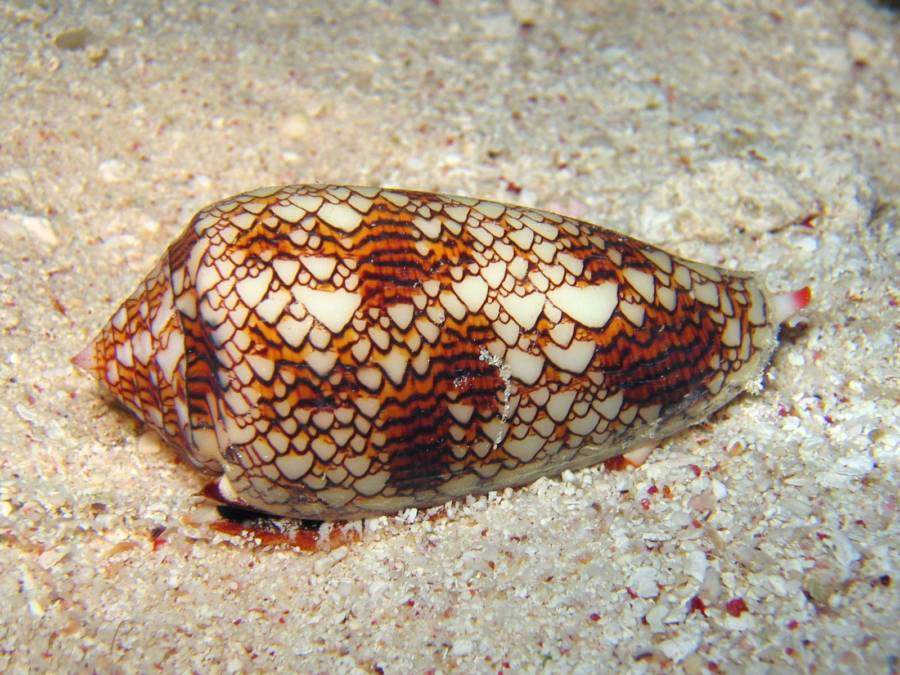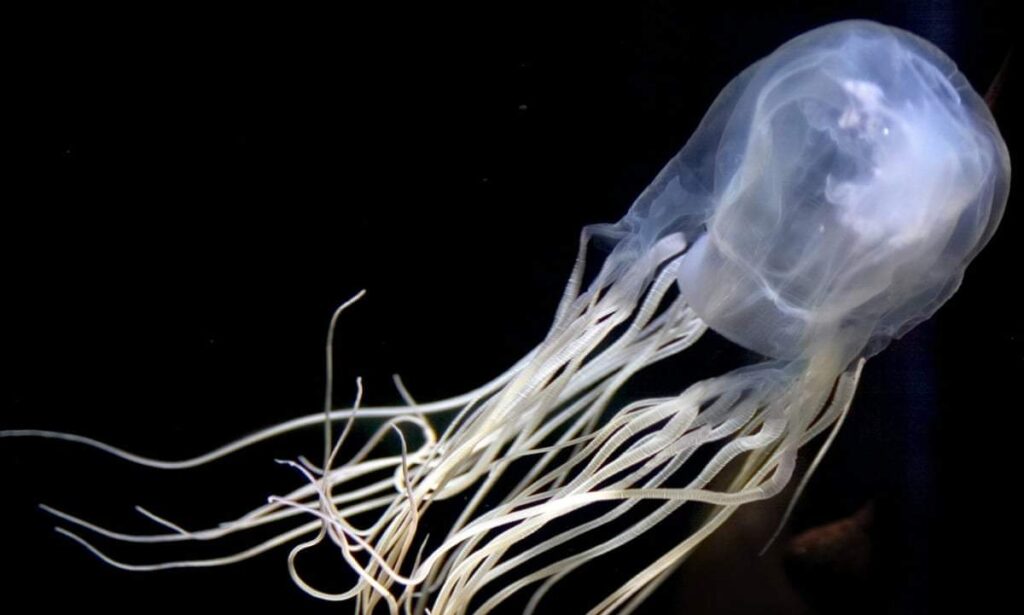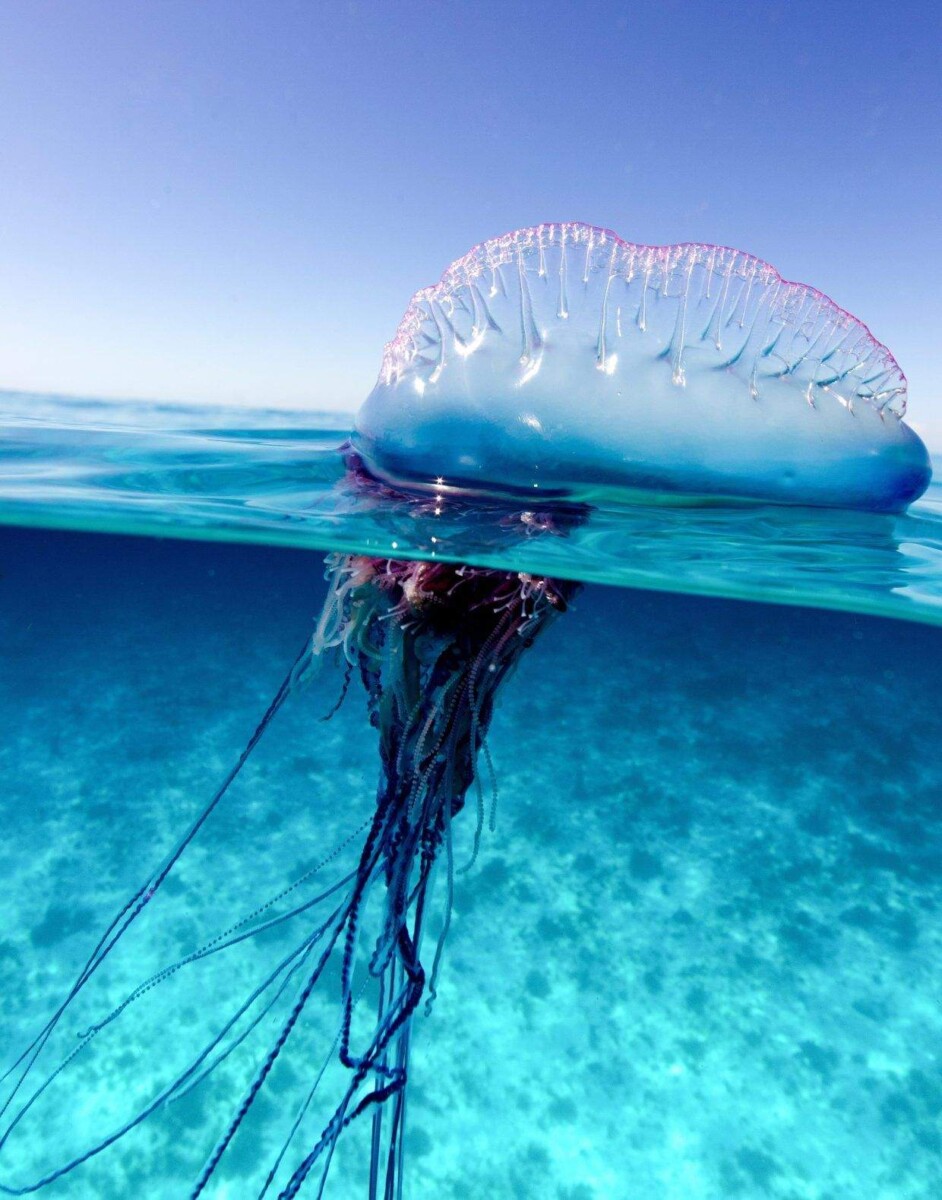I was once on a dive in Australia where the instructor warned us of cone snails. He said a man recently died after picking one up and tucking it inside his wetsuit. Cone snails are so small and innocent looking. That got me to thinking. What other unsuspecting creatures are capable of killing divers? So I did some research and compiled a list.
Scuba diving is one of the most adventurous activities you can do. There are entire worlds under the water full of amazing and wonderful things. However, it’s also a world that is dangerous to unsuspecting divers.
There are many dangerous sea creatures and some are camouflaged in beautiful shells or floating jelly-like membranes. Which ones are innocent and which ones are deadly? Let’s dive into the top 10 most dangerous marine life that you might see on your next dive.
10.) Great Barracuda

Location: Indian, Pacific, and Atlantic oceans
There are 22 species of barracuda but the great barracuda is the only species known to attack and kill humans. Sometimes referred to as the giant barracuda, they can grow up to 6 feet long and have lines of razor-sharp teeth.
Barracuda hunt small fish that sometimes have shiny skin. For this reason shiny objects attract the attention of a barracuda. Since divers sometimes carry equipment that is metal or shiny this can certainly be enough for a barracuda to attach.
To say the attack of a barracuda is ferocious would be an understatement. They are known to leave deep bits, cause severe blood loss, broken ribs, and have even punctured the lungs.
Barracuda are freakishly strong and have been known to jump out of the water and into boats where they attack people onboard.
-What to do if bitten? Apply pressure to the wound and seek medical attention if the injury is severe.
9.) Portuguese Man-O-War

Location: Tropical and Subtropical waters, Atlantic Ocean
The Portuguese man-o-war is a relative to the jellyfish. They are not the same but they are similar in many ways. The man-o-war is actually a siphonophore which is created when a colony of zooids connect and function as a unit.
Man-o-war often travels in packs of up to 1,000 so be very cautious if you see one. It’s highly likely that there are several others nearby.
The tentacles on the creature grow up to 30 feet (9 m) long and can stretch and expand up 100 feet (30 m).
Each tentacle contains hundreds of barbed tubes that administer its painful venom. The venom paralyzes small fish and other prey.
Tentacles that are detached or attached to dead species can still deliver venom. So even if you see one washed up on shore, stay away because it is still capable of stinging.
10,000 Australians get strung every single summer and while it is not usual, death from their sting is still a possibility.
The pain from a sting will last 2-3 hours and is described as severe. Stings leave long red welts on the skin and last for 2-3 days. Certain people may have allergic-type reactions from a sting. This can cause swollen and blocked airways, shock, cardiac distress, or death.
-What to do if bitten? Pour ammonia on the affected area and then follow it up with a layer of shaving cream. Using a clean razor, shave the area to remove any remaining venom stingers.
Heat applied to the area also helps reduce pain by breaking down the venom. Hot water, heating pads or heat packs are good options.
Do not apply vinegar to the sting, this increase pain and intensifies the venom.
Seek medical attention if there are symptoms of trouble breathing, or if the pain lasts longer than 3 hours.
8.) Faint-Banded and Beaked Sea Snakes

Faint-Banded 
Beaked
Location: Indian and Western Pacific Oceans
There are several species of sea snakes that are highly dangerous. However, the most dangerous of them all is the faint-banded sea snake. It’s actually the most venomous snake in the world including all land and sea species.
The faint-banded sea snakes venom is 100 times more lethal than any other snake in the world. Just a few drops of the venom is enough to kill 1,800 people. Yes, you read that right, 1,800 adult humans.
Another species to look out for is the beaked sea snake. It’s more aggressive than the faint-banded and known to be somewhat territorial. Just 3 drops of their venom can kill 8 people.
Most sea snakes are highly venomous and are all closely related to cobra snakes. Don’t worry too much though, only 25% of sea snake bites distribute venom.
The neurotoxins and myotoxins in the sea snake’s venom cause respiratory distress, muscle spasms, paralyzation, and death. Death is not common but it does occur. Many fishermen have accidentally caught sea snakes in their nets and have been bitten and died as a result.
Some other symptoms of a bite include blurry vision, muscle weakness, cramping, joint pain, drooling, vomiting, and paralysis.
Like land snakes, the venom is administered through the fangs of a sea snake during a bite. Most have short teeth which can’t always penetrate wetsuits. Most, but not all and it is still possible to get bitten on the hand if your skin is exposed.
As a diver, if a snake feels trapped, stressed or threatened it will bite. There is a 100% chance of that. Never corner a snake in an attempt to take a photo or flash it with bright lights.
Since they have lungs instead of gills, sea snakes need to come to the surface to breathe. It’s because of this that they tend to remain in shallow waters.
Generally speaking, sea snakes are shy and prefer to retreat rather than attack. However, most divers who get bit unknowingly disturb nests during mating season.
-What to do if bitten? Victims do not usually notice the bite until 30 minutes after it occurs. Tightly wrap the affected area to immobilize it.
Do not attempt to extract the venom out by either sucking or cutting the area. It will not work.
There is a 3% chance of death when bitten and there is an anti-venom available for most species of sea snakes. Anti-venom is most effective if administered within 8 hours of a bite.
Seek medical attention if the victim is having difficulty breathing, or shows signs of paralysis.
7.) Stingrays

Location: Tropical and Subtropical waters
Stingrays are generally very gentle and docile creatures. You’ll often see people petting them or swimming beside them. While it is true that they prefer to be relaxed they will sting you if they feel threatened, are disturbed, or get stepped on. A potent sting that was made famous back in 2006 when a stingray killed Steve Irwin, the Crocodile Hunter.
The bite of a stingray is felt immediately and it is very painful. The puncture wound is almost always large and deep. The tail of a stingray is essentially a knife that stabs your flesh, injects poison, and slices the wound wider as the tail retracts and exits.
The base of the tail contains a spine and has serrated edges that puncture the victim. The tail also contains venom glands that project poison at the same time as the tail strikes. The venom contains phosphodiesterase, 5-nucleotidase, and serotonin. The serotonin causes muscle contractions and pain while enzymes in the venom cause tissue and cell death.
The bigger the stingray the more extreme the sting will be. A stingray bite is not always deadly however any punctures near the heart, lungs, or other vital organs are more likely to result in death. Many people will develop an allergic reaction to the venom and should seek medical attention immediately.
-What to do if bitten? Use salt water to help clean the affected area. Apply pressure to the wound to encourage the venom to work it’s way back out of the entry hole.
Apply hot water (110-115 F / 43-46 C) to the wound every 30 minutes.
Seek immediate medical attention if serious symptoms such as difficulty breathing, paralysis, or fainting occur.
6.) Textured Cone Snail

Location: Indo-West waters
Many people love to collect the shells of cone snails. They are geometric, unique, and are fun for crafting. The snails hide very far back within the shell and most often appear to be empty. Cone snails can be found in warm waters and prefer to stay under rocks and coral reefs.
The textured snail is armed with hollowed harpoons that are filled with a deadly mix of conotoxins. So toxic in fact, that a single drop of venom can kill 20 men. The harpoons can easily penetrate wetsuits and gloves.
After being bit by this cone snail you may feel a slight discomfort at the spot of penetration. Respiratory paralysis is possible within 7-10 minutes after the bite. Paralysis of the entire body is possible from cone snails that are bigger than 4 inches (10 cm).
However, the most deadly effects don’t occur until several days after, and symptoms of muscle weakness can last for several months.
-What to do if bitten? Apply pressure to the site to prevent the venom from spreading. Hot water to the site reduces pain and swelling. Seek medical assistance immediately and administer CPR if necessary.
5.) Flower Urchin

Location: Indo-Pacific waters
The Guinness Book of Records classifies the flower urchin as the most dangerous sea urchin. They are a small sea animal related to the sand dollar and starfish. However, this beautiful sea creature possesses a deadly venom that contains two toxins.
- Peditoxin causes an anaphylactic shock, inhibits breathing, and can cause death.
- Contractin A is a neurotoxin that causes muscle spasms.
The flower structures on the urchin attach to your skin and distribute venom. The larger the flower structures are the more toxic the venom is. The pain from a flower urchin sting is incredibly painful and can cause skin, tissue, and bone damage.
The venom will make breathing difficult, paralyze the face and tongue, cause weakness in limbs and inhibit speech. If a diver, snorkeler, or swimmer gets stung there is a high chance of drowning.
-What to do if bitten? Check for spines left behind at the injection site as these need to be removed.
Vinegar can help dissolve deeply embedded spines that you might not be able to see.
Apply a warm compress to the site to reduce pain and swelling. Seek medical attention immediately if there are severe symptoms such as difficulty breathing, dizziness, or loss of consciousness.
4.) Blue-Ringed Octopus

Location: Tide pools, Pacific and Indian ocean
The blue-ringed octopus prefers to hide out in small crevices around the sea bed and in the coral reef. The chances of running into one are rare but that might actually be a good thing.
Their skin is yellowish and they are covered in blue and black rings. They are relatively small and range from 5-8 inches (12-20 cm). This octopus is generally rather docile but will attack if threatened. The 50-60 blue rings on their body will illuminate and almost glow and pulsate when there are ready to attack.
The blue-ringed octopus is classified as one of the most dangerous marine animals since it’s venom contains the neurotoxin tetrodtoxin. This is the same toxin found on pufferfish and poison dart frogs. One octopus has enough venom to kill 26 adult humans within minutes.
The bite of this octopus is often painless until hyperventilation and paralyzes begins. Death can occur quickly and is caused by suffocation due to paralyzes of the diagram. Since there is no anti-venom victims are usually placed on a breathing machine until symptoms go away.
-What to do if bitten: Apply pressure to the site and offer breathing assistance as needed. Seek medical attention right away.
3.) Box Jellyfish

Location: North Australia, South East Asia
This jellyfish is box-shaped and each tentacle contains deadly venom. There are over 50 species of box jellyfish with only a small number deadly to humans. However, the species that are dangerous are highly deadly.
The box jellyfish itself only grows about 8 inches (20 cm) in diameter but the tentacles grow up to 10 feet (3 m) long. Each jellyfish has between 50-60 tentacles. Each tentacle contains over 500,000 microscopic hooks filled with venom. One jellyfish has enough venom to kill 60 adult humans.
Once stung, the tentacle detaches from the jellyfish and remains attached to the victim. The tentacle will continue to inject venom as long as it is attached. The pain from a box jellyfish sting is horrendous and is likened to getting burned with a hot iron. There is an anti-venom but cardiac arrest typically occurs within 2-5 minutes.
-What to do if bitten? Use a towel or glove to remove any tentacles stuck to the site. Do not scrape at the tentacles but instead put them off.
Pour vinegar on the site to help alleviate pain and stop the flow of venom.
Do not apply heat, ice, or pressure to the site.
Seek medical attention immediately as cardiac arrest can occur within minutes of a serious sting.
2.) Stonefish

Location: Indo-Pacific waters
The most venomous fish known is the stonefish. Their venom is housed in the needle-like spines along the dorsal fin. If they are even as much as disturbed, the needles will rise and puncture their victim.
The amount of venom distributed varies on the amount of pressure applied to the fish. The harder you press against it the more venom will be injected.
The poisonous venom from this fish causes respiratory paralysis and heart failure. This bite is serious so seek medical attention right away. Luckily, there is an anti-venom.
Stonefish dwell on the sea bed and are almost perfectly camouflaged into their surrounding. Since stone fish prefer to hang out on the seafloor most people get stung on the feet.
-What to do if bitten? Apply heat or hot water (up to 133 F/ 45 C) to the site. Alternatively, vinegar helps to alleviate some of the pain at the injection site.
Inspect the injection site and see how many puncture wounds there are. The more punctures the more serious the risk of death is.
Seek anti-venom or medical attention immediately.
1.) Great White Shark

Location: South Africa, Australia, North Atlantic, Northeastern Pacific
Shark attacks aren’t common buy they definitely occur. There are 73-85 shark attacks recorded every year.
Great whites are the most likely cause of attacks. As of 2020 there have been a total recorded 326 unprovoked attacks by great white sharks.
Great white sharks grow 15-20 feet (4-6 m) and can weigh up to 5,000 pounds (2,268 kg). They have 5 rows of teeth and a total of 3,000 teeth. It’s estimated that an average great white shark has a bite strength of 4,000 psi (per square inch).
To put that in perspective, lions have a bite strength of 650 psi and a hippopotamus has 2,000 psi
The other two species of sharks that are aggressive and will attack are the tiger shark and the bull shark.
The chance of dying in a shark attack are 1 in 3,700,000. When a great white attacks it sneaks up from behind its victim, bites, and trashes from side to side.
Shark attacks are drastically on the rise over the last decade. Attacks on swimmers have been recorded just 10 feet (3 m) from the shoreline. There have also been numerous divers who have died or been seriously injured by sharks.
What to do if attacked? Instead of punching at the shark, gouge it in the eye. Get out of the water immediately.
Apply pressure to serious wounds to stop excessive bleeding. Seek immediate medical attention.

